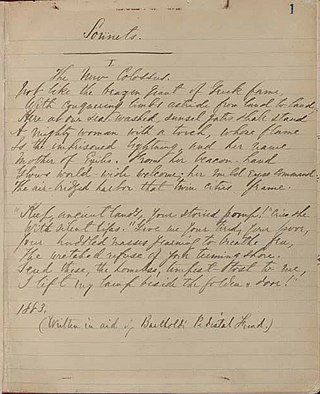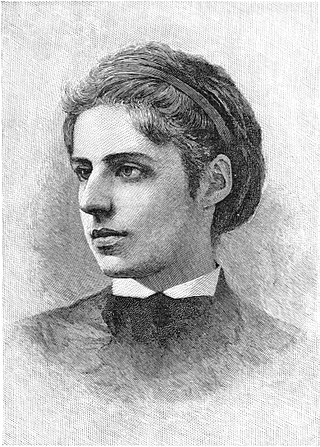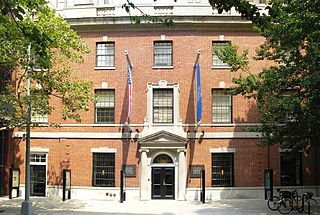
"The New Colossus" is a sonnet by American poet Emma Lazarus (1849–1887). She wrote the poem in 1883 to raise money for the construction of a pedestal for the Statue of Liberty. In 1903, the poem was cast onto a bronze plaque and mounted inside the pedestal's lower level.

Emma Lazarus was an American author of poetry, prose, and translations, as well as an activist for Jewish and Georgist causes. She is remembered for writing the sonnet "The New Colossus", which was inspired by the Statue of Liberty, in 1883. Its lines appear inscribed on a bronze plaque, installed in 1903, on the pedestal of the Statue of Liberty. Lazarus was involved in aiding refugees to New York who had fled antisemitic pogroms in eastern Europe, and she saw a way to express her empathy for these refugees in terms of the statue. The last lines of the sonnet were set to music by Irving Berlin as the song "Give Me Your Tired, Your Poor" for the 1949 musical Miss Liberty, which was based on the sculpting of the Statue of Liberty. The latter part of the sonnet was also set by Lee Hoiby in his song "The Lady of the Harbor" written in 1985 as part of his song cycle "Three Women".
Jews in Philadelphia can trace their history back to Colonial America. Jews have lived in Philadelphia since the arrival of William Penn in 1682.
Hannah Bachman Einstein was an American social worker and activist who helped establish child welfare boards in the United States.

Frances Jacobs was born in Harrodsburg, Kentucky, to Jewish Bavarian immigrants and raised in Cincinnati, Ohio. She married Abraham Jacobs, the partner of her brother Jacob, and came west with him to Colorado where Wisebart and Jacobs had established businesses in Denver and Central City. In Denver, Frances Jacobs became a driving force for the city's charitable organizations and activities, with national exposure. Among the philanthropical organizations she founded, she is best remembered as a founder of the United Way and the Denver's Jewish Hospital Association.
The American Jewish Historical Society (AJHS) was founded in 1892 with the mission to foster awareness and appreciation of American Jewish history and to serve as a national scholarly resource for research through the collection, preservation and dissemination of materials relating to American Jewish history.
The First Aliyah, also known as the agriculture Aliyah, was a major wave of Jewish immigration (aliyah) to Ottoman Palestine between 1881 and 1903. Jews who migrated in this wave came mostly from Eastern Europe and from Yemen, stimulated by pogroms and violence against the Jewish communities in those areas. An estimated 25,000 Jews immigrated. Many of the European Jewish immigrants during the late 19th-early 20th century period gave up after a few months and went back to their country of origin, often suffering from hunger and disease.
The Second Aliyah was an aliyah that took place between 1904 and 1914, during which approximately 35,000 Jews, mostly from Russia, with some from Yemen, immigrated into Ottoman Palestine.

HIAS is a Jewish American nonprofit organization that provides humanitarian aid and assistance to refugees. It was established on November 27, 1881, originally to help the large number of Russian Jewish immigrants to the United States who had left Europe to escape antisemitic persecution and violence. In 1975, the State Department asked HIAS to aid in resettling 3,600 Vietnam refugees. Since that time, the organization continues to provide support for refugees of all nationalities, religions, and ethnic origins. The organization works with people whose lives and freedom are believed to be at risk due to war, persecution, or violence. HIAS has offices in the United States and across Latin America, Europe, Africa, and the Middle East. Since its inception, HIAS has helped resettle more than 4.5 million people.

The Center for Jewish History is a partnership of five Jewish history, scholarship, and art organizations in New York City: American Jewish Historical Society, American Sephardi Federation, Leo Baeck Institute New York, Yeshiva University Museum, and YIVO Institute for Jewish Research. Together, housed in one location, the partners have separate governing bodies and finances, but collocate resources. The partners' collections make up the biggest repository of Jewish history in the United States. The Center for Jewish History also serves as a centralized place of scholarly research, events, exhibitions, and performances. Located within the center are the Lillian Goldman Reading Room, Ackman & Ziff Family Genealogy Institute and a Collection Management & Conservation Wing. The Center for Jewish History is also an affiliate of the Smithsonian Institution.

The Jewish Board of Family and Children’s Services is one of the United States' largest nonprofit mental health and social service agencies, and New York State's largest social services nonprofit.
Israeli Americans are Americans who are of full or partial Israeli descent. In this category are those who are Israelis through nationality and/or citizenship. Reflecting Israel's demographics, while the vast majority of the Israeli American populace is Jewish, it is also made up of various ethnic and religious minorities; most notably the ethnic Arab minority, which includes Christians, Druzes, and Muslims, as well as the smaller non-Arab minority ethnic groups.

The American Hebrew was a weekly Jewish magazine published in New York City.
Dos Abend Blatt was a Yiddish-language daily newspaper published in New York City, United States. Dos Abend Blatt was launched as an outgrowth of the weekly Di Arbeter Tsaytung. Published between 1894 and 1902, it was an organ of the Socialist Labor Party of America (SLP).
Over the course of Jewish history, different attitudes have been held towards poverty and wealth. Unlike Christianity, in which some strands have viewed poverty as virtuous and desirable, Jews have generally viewed poverty negatively. Jacobs and Greer assert, "In general, Jewish texts have portrayed poverty as an unjustifiable burden". In contrast to the consistently negative view of poverty, Kravitz and Olitzky describe a rapidly changing attitude towards acceptance of wealth as desirable as the Hebrews transitioned from being nomadic shepherds to farmers, then ultimately to city dwellers.
Rose Sommerfield (1874–1952) was an American teacher, activist, and social worker. She helped to develop the first home for Jewish working girls in the United States.
The Jewish Women's Congress was held at Chicago, Illinois, on 4–7 September 1893 as part of the World's Parliament of Religions at the World's Columbian Exposition. Chaired by Hannah G. Solomon, it the first gathering of Jewish women who came together for the consideration of something other than charity or mutual aid. During the conference, there was conceived an idea which developed into the National Council of Jewish Women, a permanent organization to unite Jewish women in the United States.

How the Jews Care For Their Poor is a lost 1913 American silent film directed and written by Max Abelman and Benjamin H. Namm and produced by Universal Film Manufacturing Company. The film was conceived and created by the Brooklyn Federation of Jewish Charities, an agency for Jewish philanthropic fundraising with headquarters in Brooklyn, New York. The film represented an early and successful effort to make use the new medium of film as an adjunct for charitable fundraising.
Nathan Bijur was a Jewish-American lawyer and judge from New York.








